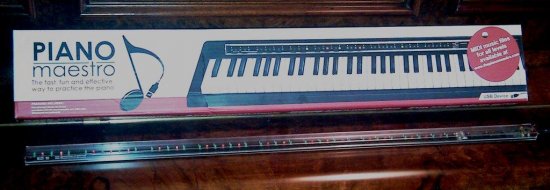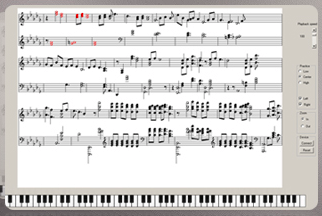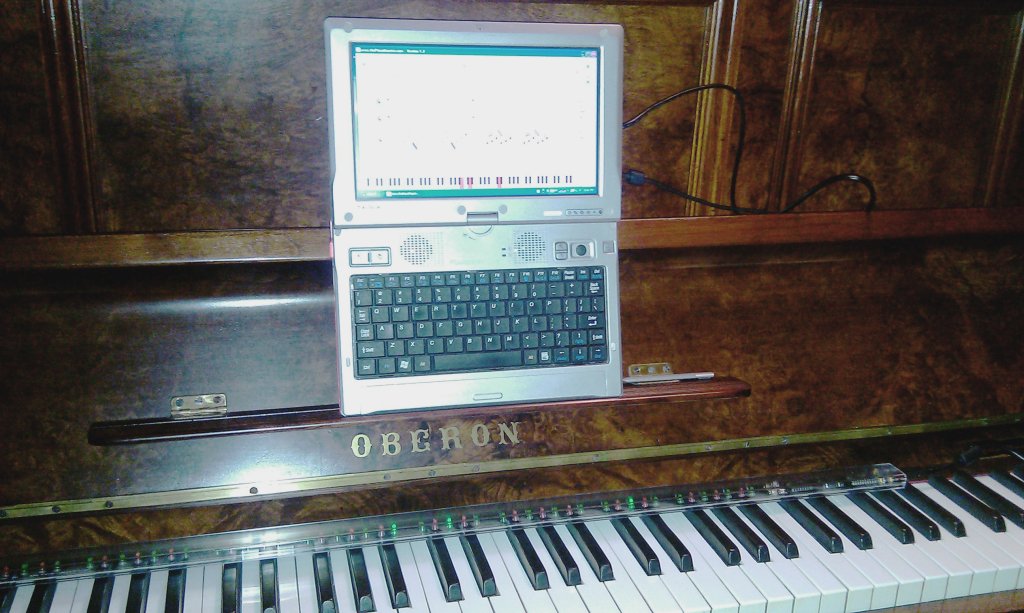 Here is an Australian invention that got me and my family really excited: the PianoMaestro.
Here is an Australian invention that got me and my family really excited: the PianoMaestro.
What is a PianoMaestro you might ask? It’s an electronic teaching and tutoring aid for piano students and which aims to make learning the piano an enjoyable experience. If this could be true, bring it on! So let’s see how the PianoMaestro is able to achieve -at a fraction of the cost- what we look for in human piano teachers.
The idea is rather simple. The PianoMaestro is a strip of coloured lights that is put across the piano keys where the LEDs indicate the next key to be pressed. It gets that information from a MIDI file of piano music which you can download for free from any number of websites. The MIDI file produces a score of sheet music on your laptop into which you also have the PianoMaestro light strip attached via a USB port. You can then hear a piece of classical music played for instance on your notebook and follow the score along and familiarise yourself with this music. Along with the score of notes that are being highlighted as the music plays, the same notes are also highlighted on a representation of the piano keyboard at the bottom of the screen as well as on the actual light strip.
We are all familiar with the electronic keyboards that have these guiding lights built in and these achieve the same purpose. But there are countless thousands of pianos out there that are not being used that can benefit from a teaching device such as the PianoMaestro. The reason that people often give up on learning to play the piano is they get frustrated with the difficulty of a certain piece that they cannot seem to master without the continual aid of a (expensive) piano teacher.
Such was the case with the inventor of the PianoMaestro, Ken Ihara.

So How Did We Fare with the PianoMaestro?
Installation was easy: load the software onto your Windows PC. You might have to restart the computer even though the software does not prompt you for this. At the same time it provides you with a collection of some 250 mainly classical pieces. Some of these are very simple and others are devilishly complicated and difficult. So there is a full range of pieces to learn. We started out with a piece from Bach which was fairly easy. Now initially you listen to this piece at the normal pace to get familiar with the tune but when you learn the actual fingering you might need to slow down to maybe 20% of the actual speed. The software gives you great flexibility in doing that. It also allows you to repeat a difficult score by letting you set the beginning and the end of the series of notes you want to practise. Once you have mastered that sequence you can then move on with the next section. In fact, Ken Ihara explains that this is the secret to using the PianoMaestro: you need to use the repeat function rather than trying to learn the whole piece at once.
We certainly concur with this philosophy. Our youngest daughter has been trying to learn the piano by herself for a few years now by diligently following the notes on her sheet music. She has accomplished quite a bit in that the time without the aid of any piano teacher. This is not an ideal situation of course but many families would be in the same predicament. A device as the PianoMaestro is indeed a godsend for these people willing to learn an instrument that can bring so much joy when it is played well.

Some Practical Notes
Currently PianoMaestro is only available for the Windows platform. Undoubtedly other versions will follow, with the Mac edition probably first. The same with the length of the light strip: at the moment the length stretches over 48 keys rather than the full keyboard of most pianos. When you are learning to play this poses not so much of a problem but with more demanding music pieces the score might include notes from the lower or higher spectrum so it is not surprising that PianoMaestro also thought about bringing out a light bar that spans the full keyboard. For now the PianoMaestro software enables the user to select which part of the piano keyboard to practice. It is not ideal but it is a workable solution. I would suggest that the company only includes pieces of music that stay within the 48 key range for this particular light strip. And it would be handy too if the music library was labelled properly so that if you were looking for “Für Elise” it would be easy to find.
Ken Ihara, when queried about this in an exchange of emails, mentioned that “95% of the notes of these [included] pieces will fall within 4 octaves and 99% of the notes fall within 6 octaves. I ultimately settled on four octaves because I thought at the time that it would be sufficient for beginner / intermediate piano players. “
Currently, in the software you can set the program to “low”, “center” or “high”. This shifts middle C by one octave up or down on the light bar, so that you can learn the high and low notes of a song and effectively cover a 6 octave range, or 72 keys (but only 4 octaves at one time).
Most people would install the software on a traditional notebook or netbook but the best platform for this is of course a Tablet PC or an iPad. Why? Then you can position the tablet right there where normally you have your sheet music. We had an old but small convertible PC that we could position in our line of sight but a tablet platform would be perfect. That means of course that the user interface needs to be rewritten somewhat so that you can easily change things by touching the screen. All these things are a big task for the very small company that PianoMaestro currently is. It is truly amazing that Ken Ihara has been able to bring out this device with very limited manpower! As the company grows you will see all these things implemented over time. Who knows, they might even bring out their own branded Tablet PC with a huge library of music installed.…
Conclusion
For the price of just a few piano lessons (just AUD139) you will have a teaching device that would last you a lifetime and gives access to learning to play the piano to all the members of the family. It is great to see that here we have an Australian invention that could potentially blow the dust of thousands of acoustic pianos all over the world! The price is right, the software is adequate but can easily be improved (particularly for Tablet PC use) and the whole concept and execution is very simple. But then again some of the best inventions are rather simple. It is just that someone has to think about the problem, have the skills and drive to come up with a solution and market the product worldwide. PianoMaestro seems to have just done that. Congratulations!
Highly recommended!
More info at PianoMaestro’s website.


